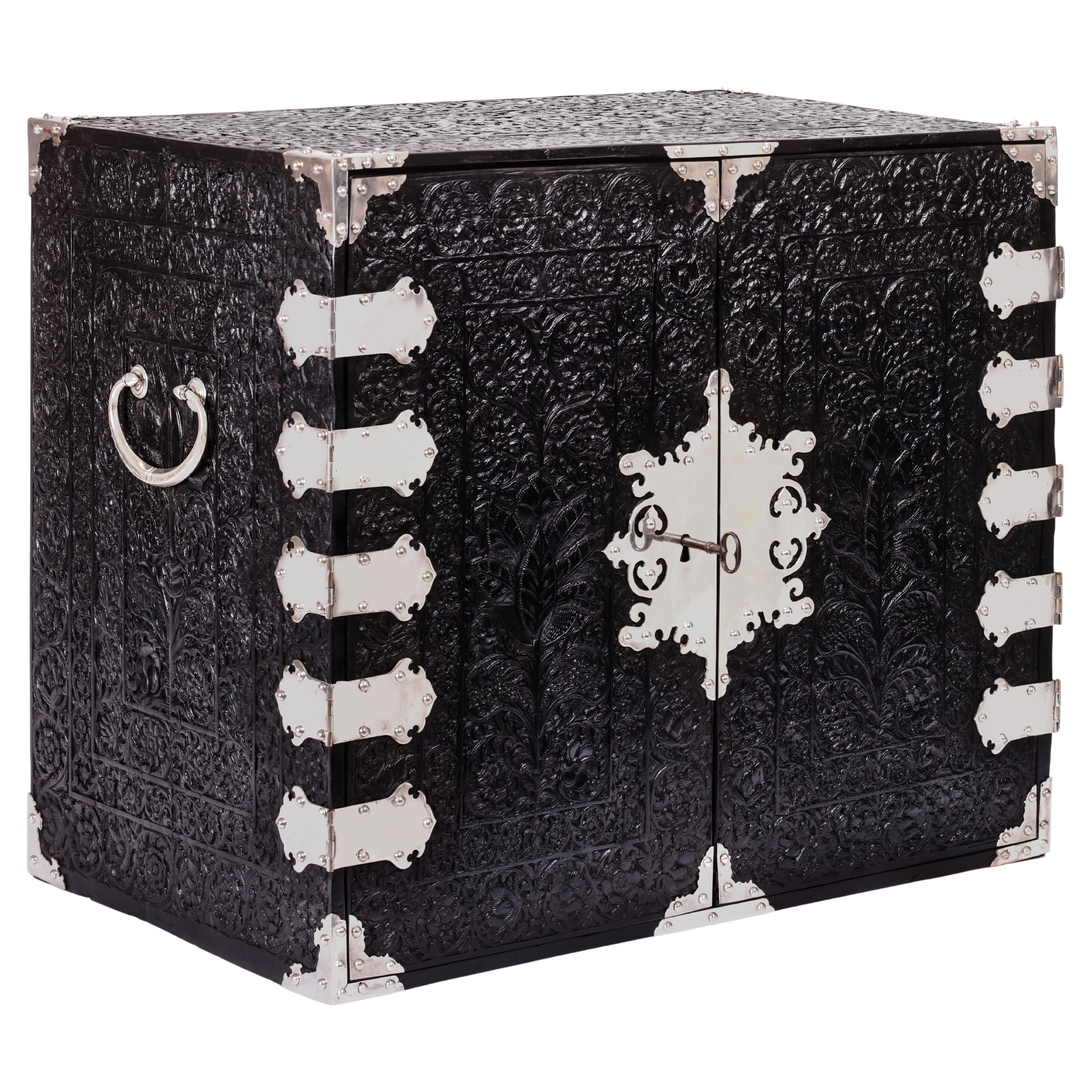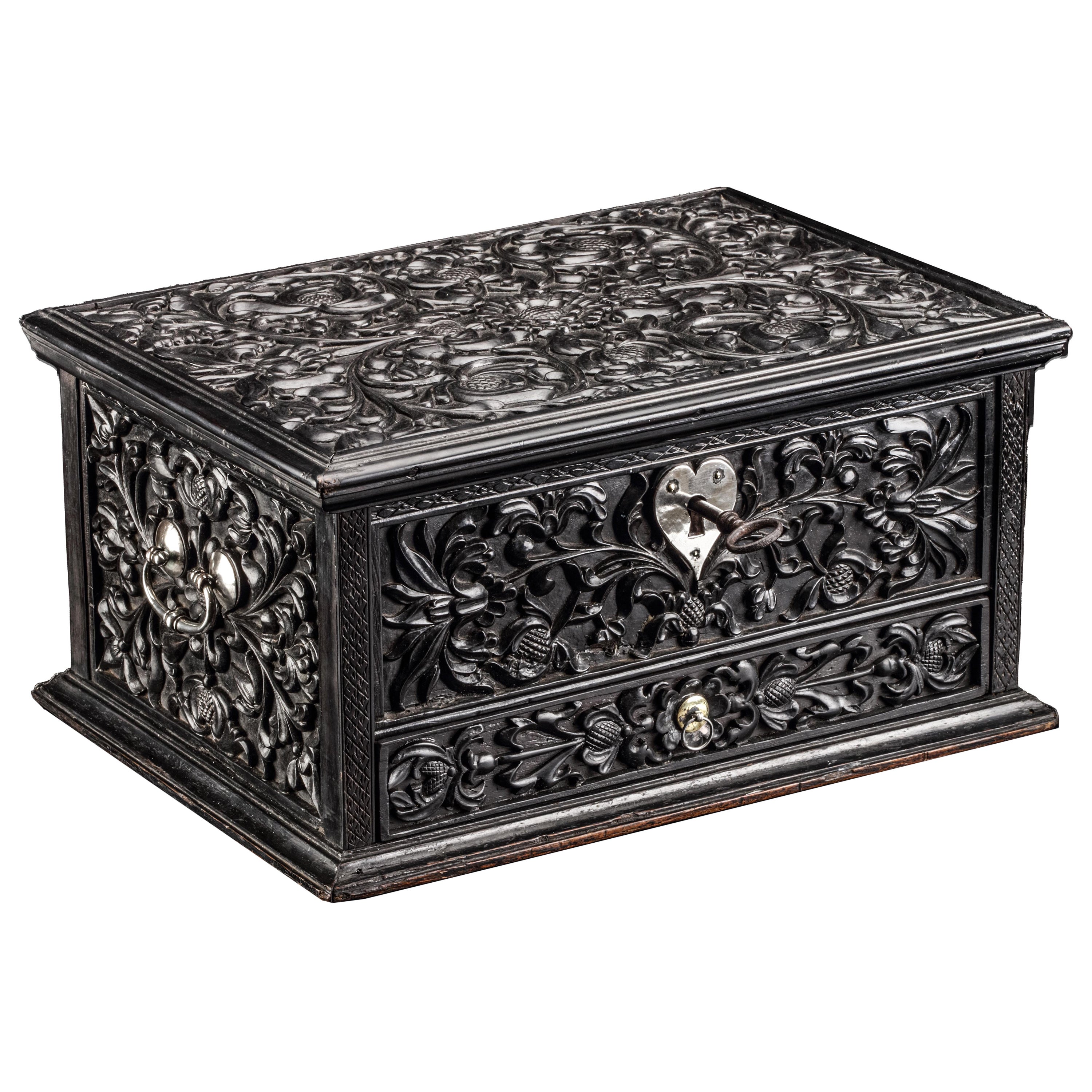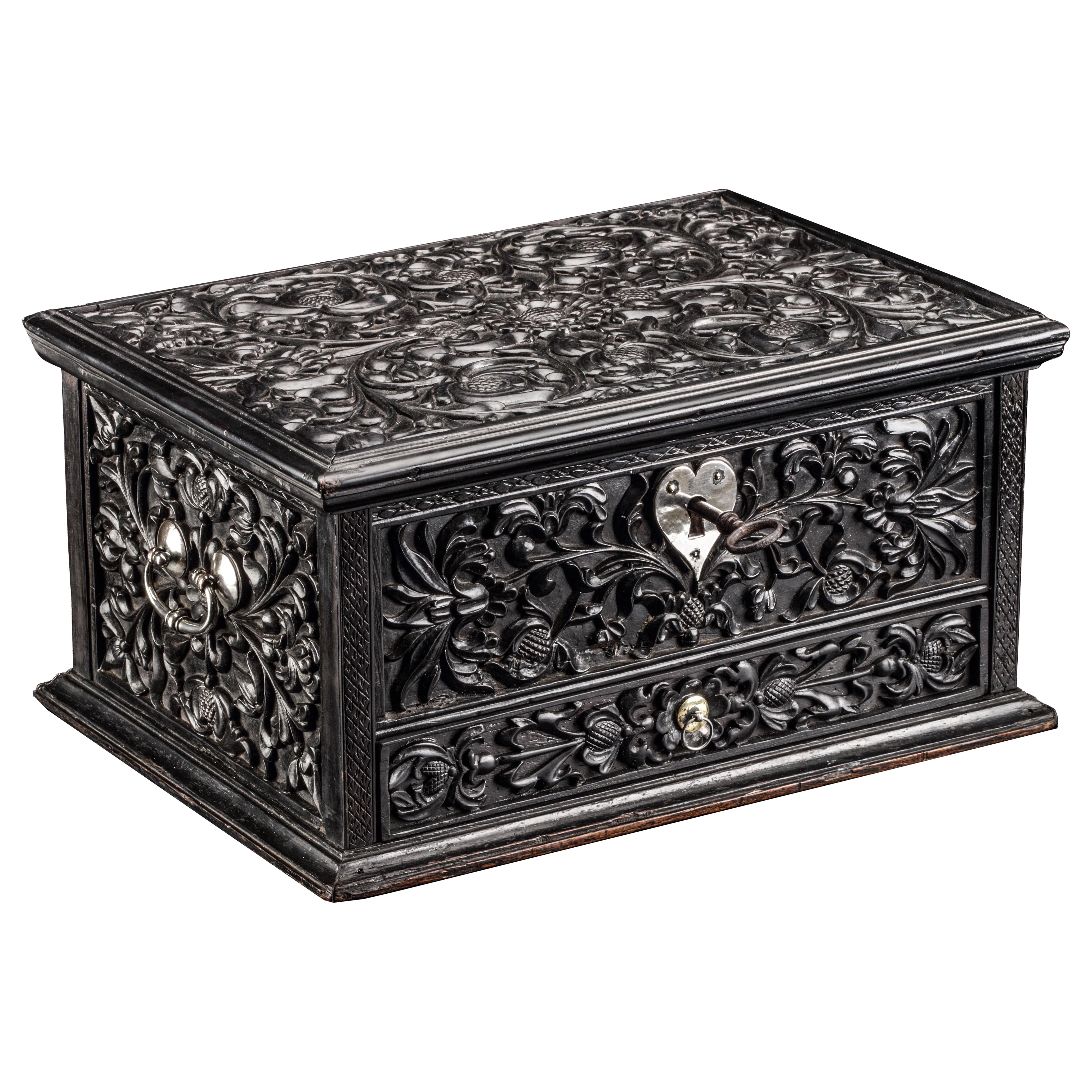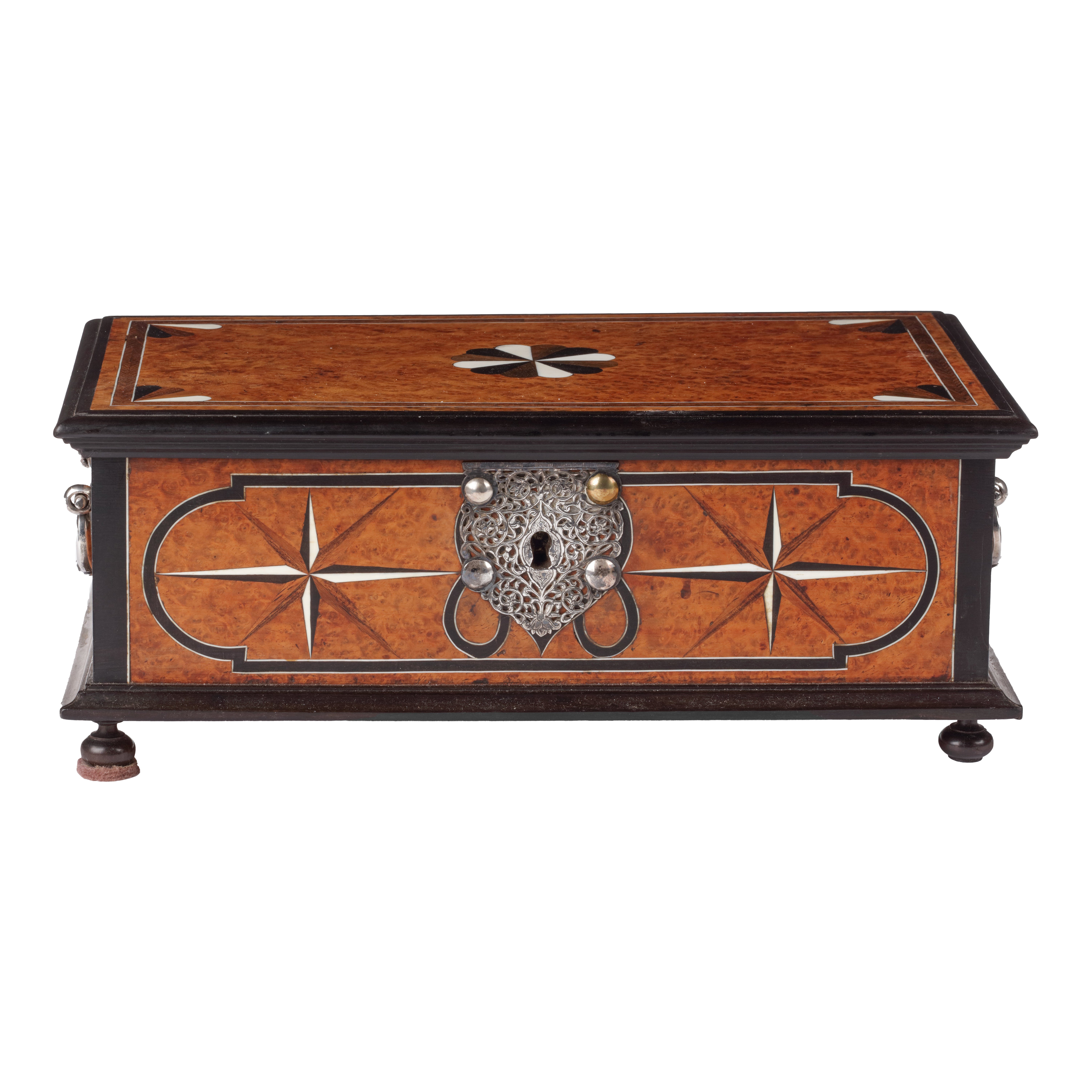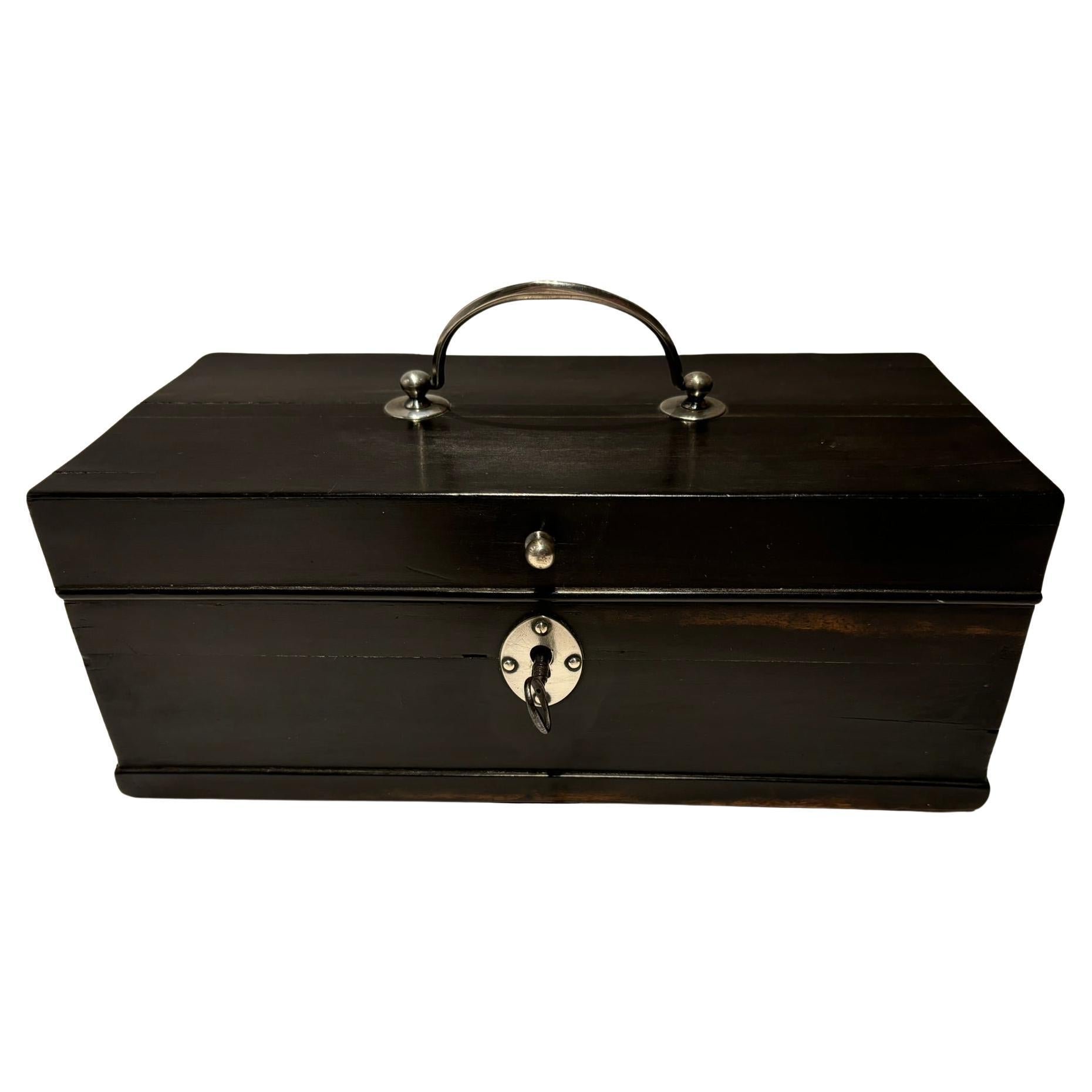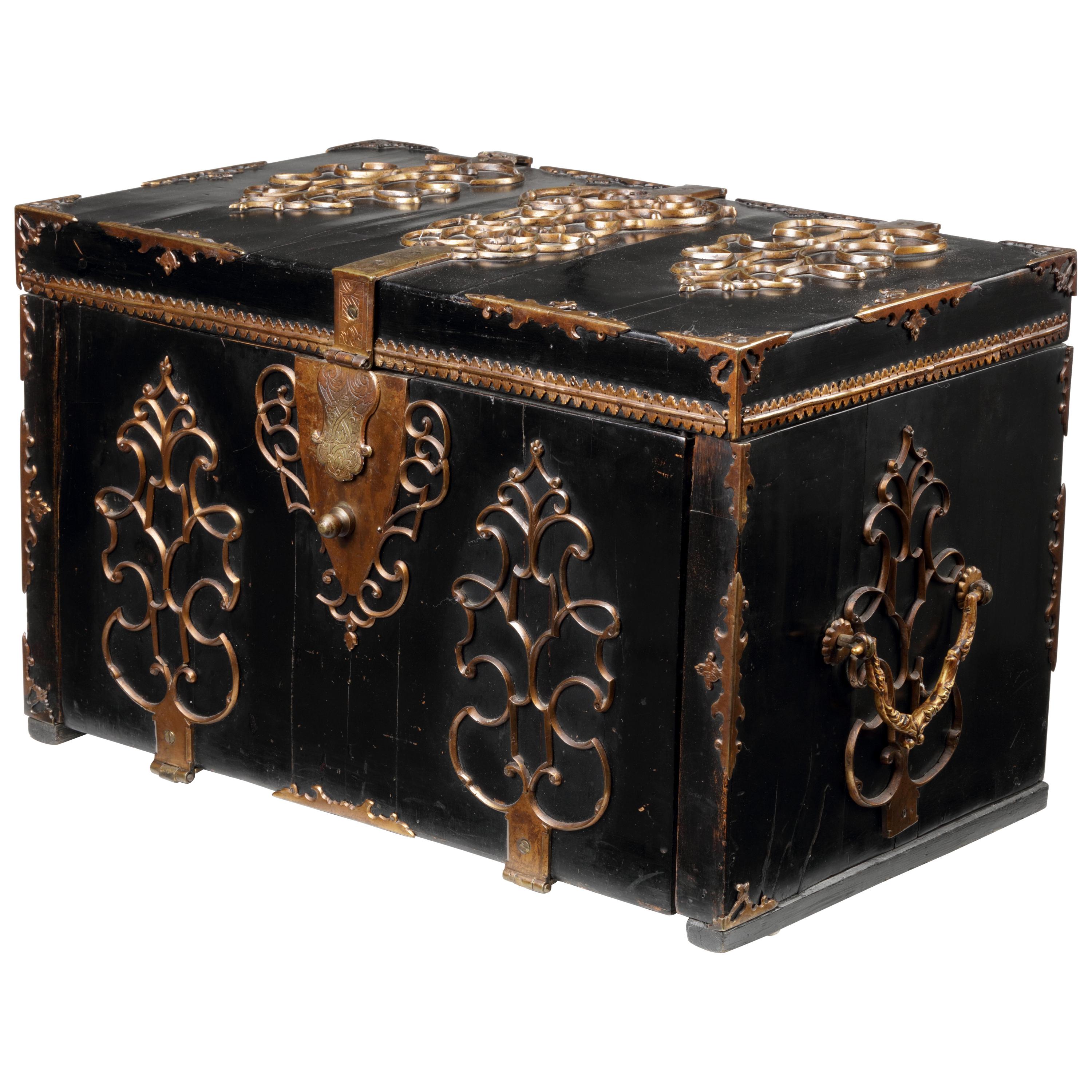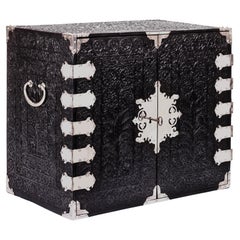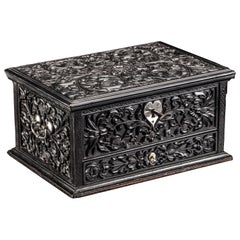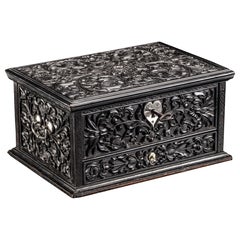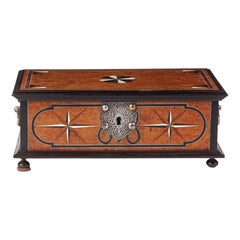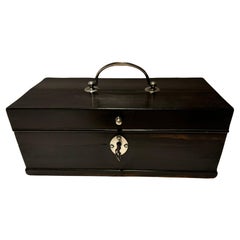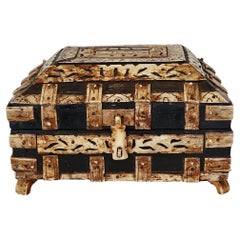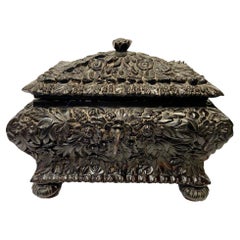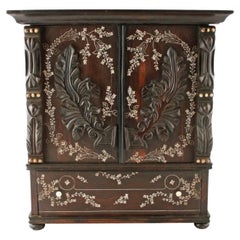Items Similar to 17th century colonial Sinhalese ebony two-door cabinet with silver mounts
Want more images or videos?
Request additional images or videos from the seller
1 of 12
17th century colonial Sinhalese ebony two-door cabinet with silver mounts
$55,000
£41,755.06
€47,758.88
CA$76,842.98
A$85,466.16
CHF 44,627.77
MX$1,040,032.29
NOK 569,964.78
SEK 534,526.41
DKK 356,442.85
Shipping
Retrieving quote...The 1stDibs Promise:
Authenticity Guarantee,
Money-Back Guarantee,
24-Hour Cancellation
About the Item
A splendid Dutch-colonial Sinhalese ebony two-door cabinet with silver mounts
Sri Lanka, Kandy, 2nd half 17th century, the mounts later
The cabinet with a central drawer with hidden compartment and the top drawer divided into four compartments. The surface carved all-over with scrolling plants issuing fleshy lotus palmettes, and in addition the exterior of the doors with a pair of kinnaris, the top with a seated deity encircled by birds, the back with a central lotus rosette flanked by quadrupeds and birds, and lastly the sides with a serapendiya, bordered by narrow diaper kundi rakkan bands.
H. 29 x W. 32.5 x D. 23 cm
The richly decorated panels carved in differing degrees of relief reveal the skill of the Sinhalese craftsmen and the scrolls issuing a richness of flowers and fruits are indicative of the island’s vegetal abundance. Their stylization is result of a cross-fertilization of Dutch and Sinhalese decorative elements that appear on furniture, textiles and silver that later appeared across the Asian VOC territories. The mythical kinnaris, serapendiya and the kundi rakkan banding are typical forms of Sinhalese ornamentation, but not often seen on furniture for the Dutch. (Mediaeval Sinhalese Art, Ananda K. Coomaraswamy, Pantheon Books 1908).
For cabinets of similar form and decoration see: Furniture from Indonesia, Sri Lanka and India during the Dutch period, Jan Veenendaal, 1985 pl.25, 29 and 58. Comparable Sinhalese furniture and objects with related carved decoration can be found in the Royal Collection Trust (21610, 21611), the Museum of Fine Arts Boston (1993.29) and the British Museum (1943.0712.4).
Provenance:
Private collection, United Kingdom
Peter Lang, United Kingdom
- Dimensions:Height: 11.42 in (29 cm)Width: 12.8 in (32.5 cm)Depth: 9.06 in (23 cm)
- Style:Dutch Colonial (Of the Period)
- Materials and Techniques:
- Place of Origin:
- Period:
- Date of Manufacture:circa 1650-1690
- Condition:Wear consistent with age and use.
- Seller Location:Amsterdam, NL
- Reference Number:1stDibs: LU5458233746752
About the Seller
5.0
Recognized Seller
These prestigious sellers are industry leaders and represent the highest echelon for item quality and design.
Established in 1985
1stDibs seller since 2020
23 sales on 1stDibs
Typical response time: 2 hours
- ShippingRetrieving quote...Shipping from: Amsterdam, Netherlands
- Return Policy
Authenticity Guarantee
In the unlikely event there’s an issue with an item’s authenticity, contact us within 1 year for a full refund. DetailsMoney-Back Guarantee
If your item is not as described, is damaged in transit, or does not arrive, contact us within 7 days for a full refund. Details24-Hour Cancellation
You have a 24-hour grace period in which to reconsider your purchase, with no questions asked.Vetted Professional Sellers
Our world-class sellers must adhere to strict standards for service and quality, maintaining the integrity of our listings.Price-Match Guarantee
If you find that a seller listed the same item for a lower price elsewhere, we’ll match it.Trusted Global Delivery
Our best-in-class carrier network provides specialized shipping options worldwide, including custom delivery.More From This Seller
View AllA 17th century Dutch-colonial ebony two-door VOC cabinet with silver mounts
Located in Amsterdam, NL
A Dutch-colonial ebony two-door cabinet with silver mounts
Coromandel Coast, probably Masulipatnam, circa 1650-1680, the silver later
H. 64.5 x W. 75 x D. 46 cm
The present cabinet...
Category
Antique 17th Century Indian Dutch Colonial Antiquities
Materials
Silver
A Dutch colonial ebony box with silver mounts
Located in Amsterdam, NL
Batavia (Jakarta), or Sri Lanka, circa 1680-1720
The document or money box is densely carved with fine scrolling vines and lotus flowers. It has a charming heart- shapes silver lock...
Category
Antique Late 17th Century Indonesian Dutch Colonial Antiquities
Materials
Silver
A Dutch colonial ebony box with silver mounts
Located in Amsterdam, NL
Batavia (Jakarta), or Sri Lanka, circa 1680-1720
The document or money box is densely carved with fine scrolling vines and lotus flowers. It has a charming heart- shapes silver lock...
Category
Antique 17th Century Indonesian Antiquities
Materials
Silver
A highly refined Dutch-colonial Sri Lankan inlaid box with silver mounts
Located in Amsterdam, NL
Galle district, 18th century
The box is made of amboyna burr with inlays of ebony, bone and burr wood and has several interior compartments, all made with the utmost attention to de...
Category
Antique 18th Century Sri Lankan Decorative Boxes
Materials
Bone, Ebony, Amboyna
Ebony Veneered Captain's Chest or Strong Box 'Coffre Fort', 17th Century
Located in Amsterdam, NL
A strongbox was a type of travelling chest and these types of boxes were more common in England than anywhere else where they were fabricated between 1660 and 1720. The earliest proo...
Category
Antique Late 17th Century Dutch Dutch Colonial Decorative Boxes
Materials
Brass
Fine Dutch Colonial Indonesian Casket with Silver Mounts, circa 1706
Located in Amsterdam, NL
A fine Indonesian Ambonya burl, ebony and teak casket with silver mounts
Jakarta (Batavia), circa 1706 (year letter W (1705-1710), marked DV, probably Dirck Vooght
The outer ri...
Category
Antique Early 18th Century Indonesian Dutch Colonial Decorative Boxes
Materials
Sterling Silver
You May Also Like
19th Century Dutch Ebony Box With Silver Mounts and Hinges
Located in Stamford, CT
Dutch Colonial ebony box with silver mounts, large silver hinges and the original steel lock and key. This rare box was likely made in the Dutch East India possession of Sri Lanka, o...
Category
Antique Early 19th Century Sri Lankan Dutch Colonial Decorative Boxes
Materials
Silver, Steel
Antique Vizagapatam India Table Box Ebonized Wood & Bone Carvings
Located in Forney, TX
Vizagapatam box, India, 19th century.
This highly decorative and unusual Anglo-Indian table box features rustic workmanship that adds to the character and charm of this unique Sout...
Category
Antique 19th Century Indian Anglo Raj Decorative Boxes
Materials
Bone, Wood
Colonial box in ebony wood
Located in 'S-HERTOGENBOSCH, NL
A Dutch colonial box from Batavia in the former Dutch East Indies.
Hand-carved with floral motives in ebony, used for jewelry or letters,
ca. 1800. Origi...
Category
Antique 1790s Indonesian Dutch Colonial Decorative Boxes
Materials
Ebony
Indian Ebony Miniature Cabinet, 19th Century
Located in Southall, GB
Indian ebony miniature cabinet
A late 19th to early 20th century Indian miniature ebony cabinet.
The cabinet has two doors with carved ebony and inlaid decorations.
The cabi...
Category
Antique 19th Century Indian Cabinets
Materials
Ebony
$3,837 Sale Price
20% Off
Carved ebony Box, Anglo-indian Box From Vizagapatam
Located in Bilzen, BE
An extraordinary Anglo-Indian box from Vizagapatam in fully carved solid ebony, late 19th century.
Filigree ornate and sculpted floral decoration...
Category
Antique Late 19th Century Indian Anglo-Indian Decorative Boxes
Materials
Ebony
Ceylonese 'Sri Lankan' Ebony Writing Slope
Located in Greenwich, CT
Very fine early 19th century carved ebony writing slope, the exterior richly carved with foliate decoration, the interior profusely inlaid with bon...
Category
Antique Early 19th Century Sri Lankan Anglo-Indian Decorative Boxes
Materials
Bone, Ebony, Sandalwood
More Ways To Browse
Seely Furniture
Royal Collection Trust
Dutch Jewellery
Silver Box India
Bird Jewelry Box
British Colonial Antique Furniture
Colonial India
Ebony Jewellery
17th Century Cross
17th Century Jewellery
Antique Box Seat
17th Century Dutch Silver
Colonial British India Furniture
Dutch Silver Box
Indonesia Bird
Antique Silver Boston
Royal Ebony
Antique Dutch Silver Boxes
